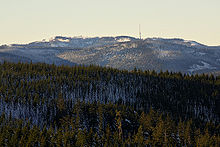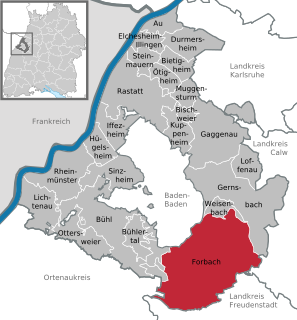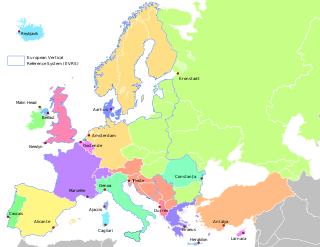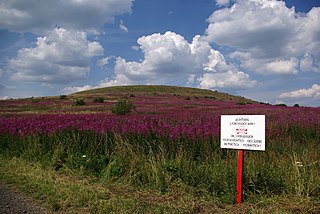
The Murg is an 80.2-kilometre-long river and a right tributary of the Rhine in Baden-Württemberg, Germany. It flows through the Northern Black Forest into the Upper Rhine Plain, crossing the counties of Freudenstadt and Rastatt.

The Wildsee is a small lake within an area of bog between Bad Wildbad and Gernsbach, high in the Northern Black Forest mountain range in southwestern Germany. The lake is fed by rain water. It is part of the Kaltenbronn Nature Reserve.

The Schwarzwaldhochstraße, or "Black Forest High Road", is the oldest, and one of the best known, themed drives in Germany. It is a part of the B 500 federal highway.

The Belchen, 1,414 metres (4,639 ft), or Black Forest Belchen is the fourth highest summit of the Black Forest after the Feldberg, Seebuck and the Herzogenhorn. The municipalities of Münstertal, Schönenberg and Kleines Wiesental meet on the summit dome of the Belchen which is located in the southwest German state of Baden-Württemberg.

The Seekopf is a mountain on the main chain of the Northern Black Forest in Germany between the Upper Rhine Plain and the Murg valley, above Seebach. It is 1,054.2 m above sea level (NHN) and lies on the boundary of the counties of Ortenaukreis and Freudenstadt in the state of Baden-Württemberg.

The Wild Gutach is a river in Baden-Württemberg, Germany. It flows into the Elz in Gutach im Breisgau.

The Black Forest National Park was created on 1 January 2014 and is the first national park in Baden-Württemberg, Germany. The state parliament voted for its establishment on 28 November 2013. The national park has an area of 10,062 hectares and is located on the main crest of the Northern Black Forest, mainly between the Black Forest High Road (Schwarzwaldhochstraße) and the valley of the Murg. It comprises two separate areas, roughly 3.5 kilometres apart, around Ruhestein and Hoher Ochsenkopf/Plättig and is part of the Central/North Black Forest Nature Park. The park was officially opened on 3 May 2014
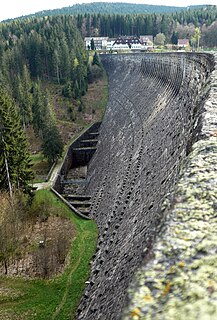
The Schwarzenbach Dam is a gravity dam near Forbach in the Northern Black Forest of Germany. It is the most important structure of the Rudolf-Fettweis-Werk's pumped storage power station. The operator of the dam, which was completed in 1926 in a side valley of the Murg valley, is EnBW Kraftwerke.

The Mehliskopf is a mountain, 1,007.8 m above sea level (NHN), on the main chain of the Northern Black Forest in Germany. It lies above the Black Forest High Road, between Sand and Hundseck. On the north flank of the mountain there is ski piste with lifts and an all-year-round bobsleigh run. Nearby is a climbing garden and an adventure playground.
Seekopf is German for “lake head” or “lake peak” and may refer to the following mountains:

The Hohloh is a mountain, 988.3 m above sea level (NHN), on the eastern main ridge of the Northern Black Forest in Germany. It lies near the village of Kaltenbronn in the borough of Gernsbach, a town in the county of Rastatt in the German state of Baden-Württemberg. Its summit is the highest point in the borough of Gernsbach and the eastern chain of the Northern Black Forest, the ridge between the rivers Murg and Enz. A mountain pass runs northeast of the summit plateau between the two river valleys passing over the saddle of Schwarzmiss.

The Bernstein is a mountain, 693.5 m above sea level (NHN), in the Northern Black Forest within the borough of Gaggenau, and the borough of Bad Herrenalb,. It is part of the ridge that borders the lower Murg valley on its eastern side. The summit of this mountain is formed by a six-metre-high crag made of bunter sandstone with a flat top, 25 m² in area, from where there are good views.
The Herrenwieser See is a tarn in the municipality of Forbach in the Northern Black Forest in Germany. It lies at a height of 830 metres, a little northwest of the Schwarzenbach Reservoir and 1,600 metres as the crow flies northeast of Herrenwies on the eastern mountainside of the 1,001-metre-high Seekopf, a subpeak of the Badener Höhe. The lake covers an area of 1.2 hectares and is up to 9.5 metres deep. Habitats Directive area and, together with the cirque headwall, designated as a biotope. It can be circumnavigated on a footpath. The lake itself is surrounded by a fence and the shore is out-of-bounds for nature conservation reasons.

The Herrenwieser Schwallung is a splash dam, built in 1844–47 of bunter sandstone, near Herrenwies in the Black Forest, which impounds the waters of the Schwarzenbach stream into a pond. In the days of timber rafting it was periodically opened and washed the fallen logs or timber rafts downstream into the valley. Today the dam acts as a bridge over the Schwarzenbach.
